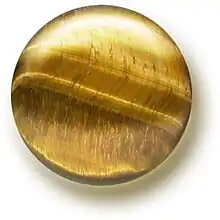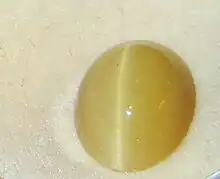In gemology, chatoyancy (/ʃəˈtɔɪ.ənsi/ shə-TOY-ən-see), or chatoyance or cat's eye effect,[1] is an optical reflectance effect seen in certain gemstones, woods, and carbon fiber. Coined from the French œil de chat, meaning 'cat's eye'. The chatoyant effect is typically characterized by one or more well-defined bands of reflected light, reminiscent of a cat's eye, which appear to glide across the material's surface as the chatoyant object or observer shifts position.
Chatoyancy is caused by either the presence of fibrous structures within the material, such as in tiger's eye quartz, or by fibrous inclusions and cavities, as seen in cat's eye chrysoberyl. In cat's eye chrysoberyl, the chatoyant effect is caused by the presence of rutile, composed mostly of titanium dioxide, which aligns perpendicularly to create the cat's eye appearance.[2][3]
Description
Chatoyancy in the gemstone chrysoberyl is induced by the presence of the mineral rutile, a mineral primarily composed of titanium dioxide. These rutile precipitates align perpendicularly, contributing to the cat's eye effect.[4] This alignment is attributed to the rutile's lattice parameter, which matches only one of the three orthorhombic crystal axes of chrysoberyl, leading to its preferred orientation in that direction.
Optimal presentation of effect
To bring out the chatoyancy effect, gemstones are typically fashioned into a cabochon cut, characterized by a rounded, flat base rather than facets, with the fibrous structures aligned parallel to the base. High-quality specimens display a single, sharply defined band of light that moves across the stone when rotated, while lower-quality stones may show a banded effect similar to cat's-eye quartz. Faceted stones do not showcase the effect well.
Varieties of chatoyant materials
Gem species known for this phenomenon include the aforementioned quartz, chrysoberyl, beryl (especially. aquamarine varieties), charoite, tourmaline, labradorite, selenite, feldspar, apatite, moonstone, thomsonite and scapolite amongst others. Chatoyancy is not limited to gemstones but can also be found in various wood species, carbon fiber. Also synthetically made gemstones made with of optical fibers can have chatoyancy. These gemstones are available in variety of vibrant colors.
Cat's eye terminology

When the term "cat's eye" is used to describe a gemstone by itself, it typically refers to cat's eye chrysoberyl [5]. It can also be used as an adjective to indicate the chatoyance phenomenon in another stone, for example, cat's eye aquamarine.
In woodworking
Chatoyancy in wood occurs in various species[6] – particularly hardwoods and the various types of Nanmu woods of China and South East Asia, particularly where stresses from the weight of the growing tree result in denser patches, or where stresses cause burl or bird’s eye. This ‘figure’, which has a striking three-dimensional appearance, is highly prized by woodworkers and their clients alike, and is featured regularly in furniture, musical instruments, and other decorative wood products. Figuring takes on a variety of forms and is referred to as flame, ribbon, tiger stripe, quilting, among other names.[7]
This effect is sometimes called wet look, since wetting wood with water often displays the chatoyancy, albeit only until the wood dries. Certain finishes cause the wood grain to become more pronounced. Oil finishes, epoxy, and shellac can strongly bring out the wet look effect. When the refractive index of the finish nearly matches that of the wood, light scattering no longer occurs at the wood surface, adding the appearance of depth to the wood's figure.
Measurement
No method to measure wood chatoyance is unanimously accepted by the scientific community. Some methods have been proposed, such as one named PZC,[8] which was used to measure typical values for a number of wood species; some results are reported below:[9]
| Wood (common name) |
PZC average |
|---|---|
| Afrormosia | 14.2 |
| Afzelia | 14.1 |
| Alder | 15.0 |
| Alder, Red | 16.8 |
| Anigre | 14.4 |
| Ash, American White | 11.5 |
| Ash, European | 12.8 |
| Ash, Olive | 14.9 |
| Beech, European | 10.6 |
| Birch | 18.3 |
| Black Locust | 16.4 |
| Bocote | 11.5 |
| Bog Oak | 11.6 |
| Bubinga | 19.2 |
| Cedar, European | 7.6 |
| Cedar, Spanish | 21.3 |
| Cerejeira | 14.1 |
| Cherry, Black | 18.0 |
| Cherry, Sweet | 15.7 |
| Chestnut, Sweet | 14.4 |
| Cypress, Mediterranean | 9.3 |
| Ebony, Macassar | 11.3 |
| Elm | 14.5 |
| Etimoe | 22.1 |
| Eucalyptus | 13.9 |
| Fir, Douglas | 11.1 |
| Fir, European Silver | 10.0 |
| Granadillo | 14.3 |
| Guarea | 17.2 |
| Ipe | 11.7 |
| Iroko | 21.8 |
| Jatoba | 17.5 |
| Khaya | 23.0 |
| Koa | 26.4 |
| Koto | 12.5 |
| Larch, European | 10.9 |
| Limba | 16.1 |
| Limba, Black | 18.7 |
| Lime, European | 12.2 |
| Louro Faia | 17.4 |
| Louro Preto | 11.3 |
| Mahogany, Honduras | 21.4 |
| Makore | 21.0 |
| Mansonia | 18.0 |
| Maple, European | 14.2 |
| Maple, Hard | 16.1 |
| Movingui | 15.3 |
| Mulberry | 18.2 |
| Oak, Red | 12.2 |
| Oak, Sessile | 12.6 |
| Obeche | 11.1 |
| Okoume | 23.6 |
| Olive | 8.3 |
| Osage Orange, Green | 17.0 |
| Ovangkol | 20.0 |
| Padouk | 17.4 |
| Pear | 10.5 |
| Pine, Swiss Stone | 10.7 |
| Pine, unspecified | 13.2 |
| Poplar | 14.7 |
| Poplar, Yellow | 11.9 |
| Purpleheart | 13.7 |
| Red Gum | 12.6 |
| Rosewood, Cocobolo | 9.5 |
| Rosewood, Indian | 11.2 |
| Rosewood, Kingwood | 14.3 |
| Rosewood, Madagascar | 11.7 |
| Rosewood, Santos | 12.5 |
| Sapele | 20.7 |
| Satinwood | 13.9 |
| Spruce, Fiemme | 9.3 |
| Sucupira | 9.8 |
| Teak | 15.7 |
| Tineo | 14.7 |
| Walnut, African | 20.2 |
| Walnut, Black | 18.6 |
| Walnut, European | 17.5 |
| Wenge | 8.5 |
| Yew | 9.8 |
| Zebrawood | 19.1 |
| Ziricote | 7.0 |
See also
- Asterism (gemology) – ornamental stones that exhibit a luminous star when cut en cabochon
- Optical phenomena – Observable events that result from the interaction of light and matter
References
- ↑ Reinersmann, Walter Schumann ; [translated by Elizabeth E.; Shea], Daniel (2008). Minerals of the world (2nd ed.). New York, NY.: Sterling Pub. Co. p. 19. ISBN 9781402753398.
{{cite book}}: CS1 maint: multiple names: authors list (link) - ↑ Mukherjee, Swapna (2011). Applied mineralogy : applications in industry and environment. Dordrecht: Springer. ISBN 978-9400711617.
- ↑ Hancock, Paul L.; Skinner, Brian J., eds. (2006). "gemstones". The Oxford companion to the earth (1st ed.). Oxford: Oxford Univ. Press. ISBN 9780198540397.
- ↑ "chrysoberyl", Dictionary Geotechnical Engineering/Wörterbuch GeoTechnik, Berlin, Heidelberg: Springer Berlin Heidelberg, p. 224, 2014, doi:10.1007/978-3-642-41714-6_31903, ISBN 978-3-642-41713-9, retrieved 2023-10-20
- ↑ "Cymophane gemstone information". www.gemdat.org. Retrieved 2023-10-20.
- ↑ "Woodworking word of the day: chatoyance | Wood". WOOD Magazine. 2022-05-24. Archived from the original on 24 May 2022. Retrieved 3 August 2022.
- ↑ "What is Chatoyance? – PZC Chatometry". 2022-01-12. Archived from the original on 12 January 2022. Retrieved 2022-05-24.
- ↑ Pisani, Paolo; Zanetta, Laura; Codoro, Davide (2021-12-29). "Measuring wood chatoyance". Wood Material Science & Engineering. 18: 277–288. doi:10.1080/17480272.2021.2018625. ISSN 1748-0272. S2CID 245572069.
- ↑ "PZC Chatometry – A standard system to measure wood chatoyance" (in Italian). Retrieved 2022-01-03.
- General
- Webster, R., Jobbins, E. A. (Ed.). (1998). Gemmologist's compendium. St Edmundsbury Press Ltd, Bury St Edwards.
- Mitchell, T. et al. Proceedings of the Electron Microscopy Society of America (EMSA), 1982.


